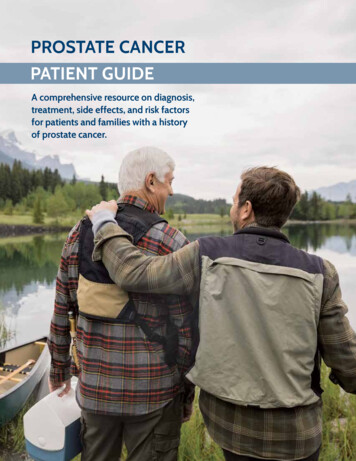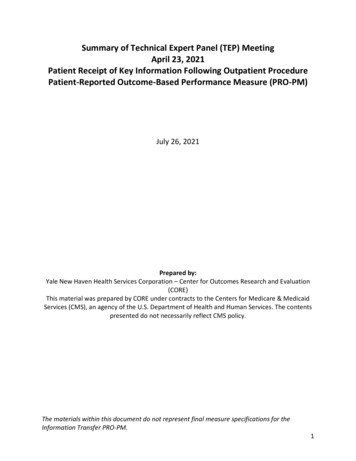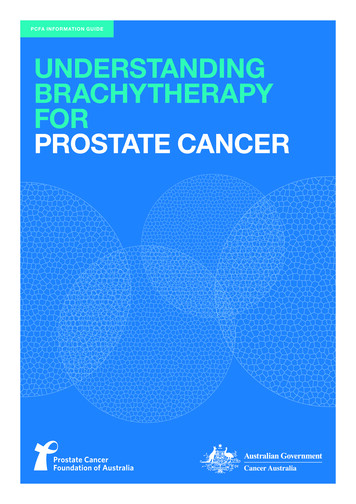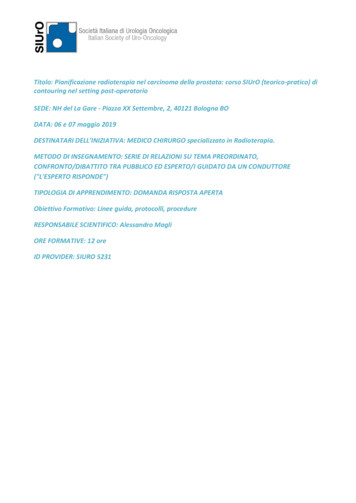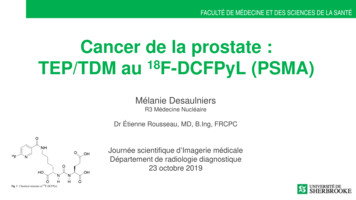
Transcription
FACULTÉ DE MÉDECINE ET DES SCIENCES DE LA SANTÉCancer de la prostate :18TEP/TDM au F-DCFPyL (PSMA)Mélanie DesaulniersR3 Médecine NucléaireDr Étienne Rousseau, MD, B.Ing, FRCPCJournée scientifique d’Imagerie médicaleDépartement de radiologie diagnostique23 octobre 2019
FACULTÉ DE MÉDECINE ET DES SCIENCES DE LA SANTÉPlan Cancer de la prostate en bref Le PSMA, c’est quoi ? TEP/TDM au 18F-DCFPyL (PSMA) Cas cliniqueGénéralitésIndicationsForces et limites Conclusion
FACULTÉ DE MÉDECINE ET DES SCIENCES DE LA SANTÉCancer de la prostate Au Canada Cancer le plus fréquent chez l’homme4e cancer le plus répandu1/7 homme recevra le diagnostic au cours de sa vieEn 2017, 21 300 hommes ont reçu le diagnostic 70% des cancers diagnostiqués en phase précoce (stade I ou II) Survie à 5 ans : 98 %
FACULTÉ DE MÉDECINE ET DES SCIENCES DE LA SANTÉCancer de la prostate Plusieurs thérapies disponibles ChirurgieHormonothérapieRadiothérapie rapieRadiothérapie interne vectorisée (théranostique) en développement Échec biochimique après une thérapie initiale à visée curative : 30% À l’intérieur du suivi de 10 ans après le diagnostic
FACULTÉ DE MÉDECINE ET DES SCIENCES DE LA SANTÉQuelques définitions Récidive biochimique PSA nadir 2 ng/mL après radiothérapie à visée curativePSA nadir 0,2 ng/mL après prostatectomie radicaleTemps de dédoublement 3 moisConfirmée par 2 mesures consécutives Résistance à la castration Testostérone sérique 0,7 nmol/LET APS de 25% (à partir de 2 ug/mL) à partir de nadir,confirmée au moins 3 semaines plus tardOUProgression radiologique de la maladie préexistante surscintigraphie ou TDM ( 2 nouvelles lésions dans les os outissus mous)
FACULTÉ DE MÉDECINE ET DES SCIENCES DE LA SANTÉLe PSMA, c’est quoi ? Glutamate carboxypeptidase II Glycoprotéine transmembranaire de type II Expression 100-1000 fois dans le cancer de la prostatecomparé aux tissus normaux Expression du PSMA augmente progressivement Hauts grades tumoraux Maladies métastatiques Maladies hormono-résistantes, dites résistantes à lacastration Astrocytes du système nerveux central Néovascularisation de certaines tumeurs solides :sein, côlon, rein, vessie Vaisseaux nouvellement formés
FACULTÉ DE MÉDECINE ET DES SCIENCES DE LA SANTÉPSMA Prostate normale Expression cytoplasmique et côté apical de l’épithéliumentourant les canaux prostatiques d’expression pour cellules neuroendocrines ou stromales Prostate dysplasique ou transformation néoplasique Transfert du PSMA de la membrane apicale vers lasurface luminale des canaux prostatiques Transition vers un cancer prostatique androgèneindépendant plus grande expression de PSMA
FACULTÉ DE MÉDECINE ET DES SCIENCES DE LA SANTÉEt le 18F-DCFPyL Un ligand du PSMA Clairance urinaire Ratio tumeur:bruit de fond plus Plus de lésions détectées que le 68Ga-PSMA-11
FACULTÉ DE MÉDECINE ET DES SCIENCES DE LA SANTÉComparaisonVSA Prospective Study on 18F-DCFPyL PSMA PET/CT Imaging in Biochemical Recurrence of Prostate Cancer, JNM 2019.
FACULTÉ DE MÉDECINE ET DES SCIENCES DE LA SANTÉCas clinique 70, adénocarcinome de laprostate stade IV d’emblée Score de Gleason 9 (4 5)APS initiale : 177Métastases Ganglionnaires (rétropéritoine,pelvis)Osseuses Diagnostic à l’hiver 2018 Cancer résistant à la castrationdepuis été 2019
FACULTÉ DE MÉDECINE ET DES SCIENCES DE LA SANTÉ
FACULTÉ DE MÉDECINE ET DES SCIENCES DE LA SANTÉ
FACULTÉ DE MÉDECINE ET DES SCIENCES DE LA SANTÉComparaisonScintigraphie osseuseTEP/TDM au 18F-DCFPyL
FACULTÉ DE MÉDECINE ET DES SCIENCES DE LA SANTÉBiodistribution normale du radiotraceurA Prospective Study on 18F-DCFPyL PSMA PET/CT Imaging in Biochemical Recurrence of Prostate Cancer, JNM 2019.
FACULTÉ DE MÉDECINE ET DES SCIENCES DE LA SANTÉIndications actuelles – Stade de recherche Récidive biochimique Stadification avant traitement curatif des cancersprostatiques à haut risque selon classification deD’AMICO 3 : Lésions suspectes à caractériser (dont métastases osseuses) Évaluation thérapeutique sous traitement Évaluation avant radiothérapie interne vectorisée en médecinenucléaire (théranostique)
FACULTÉ DE MÉDECINE ET DES SCIENCES DE LA SANTÉForces de la TEP/TDM au 18F-DCFPyL Taux de détection de 50% pour PSA 0,5 ng/mL PSA 1 ng/mL : Détecte plus de lésions secondaires que la choline(autre radiotraceur TEP pour cancer de la prostate) dans les récidivesbiochimiques Meilleure détection des atteintes ganglionnaires en bilan d’extensionpour les cancers D’AMICO 2 et 3 Taux d’impact sur la prise en charge de 65% Rousseau et al. 2019 Staging à la hausse : 97% Chirurgie/biopsie : 25% Thérapie systémique : 56% Radiothérapie : 47% Amélioration décisions cliniques : 90%
FACULTÉ DE MÉDECINE ET DES SCIENCES DE LA SANTÉLimites de la TEP/TDM au 18F-DCFPyL Faible détection pour la loge de prostatectomie TEP au 18F-DCFPyL négative bonne réponse à la radiothérapie de rattrapage Protocole d’imagerie variable 2 MBq/kg de 18F-DCFPyL vs dose fixe Acquisition dynamique sur la loge de prostatectomie vs pancorporelle Acquisition 1h vs 3h post-injection Meilleure visualisation des lésions et plus de lésions à 3h Utilisation ou non du Lasix Excrétion rénale du PSMA Perte ou non expression du PSMA 5% des cancers de la prostate ne surexpriment pas PSMA Métastases des cancers résistants à la castration peuvent perdre leur expression Surtout hépatiques « Pitfalls » à l’interprétation
FACULTÉ DE MÉDECINE ET DES SCIENCES DE LA SANTÉExempleImaging of Prostate- Specific Membrane Antigen Using [18F]DCFPyL, PET Clin 12 (2017) 289–296.
FACULTÉ DE MÉDECINE ET DES SCIENCES DE LA SANTÉUn petit mot sur la théranostiqueTreatment Outcomes from 68Ga-PSMA PET/CT-Informed Salvage Radiation Treatment in Men with Rising PSA After Radical Prostatectomy :Prognostic Value of a Negative PSMA PET, J Nucl Med., 2017 Dec;58(12):1972-1976
FACULTÉ DE MÉDECINE ET DES SCIENCES DE LA SANTÉConclusion La place de la TEP au 68Ga-PSMA Récidive biochimique Stadification initiale des hauts risques Évaluation de la réponse au traitement Principale force : Bon taux de détection de l’atteinte ganglionnaire etbilan d’extension en cas de récidive de cancer de la prostate avec unPSA aussi faible que 0,5 ng/mL Limites Faible détection à la loge de prostatectomie Protocole et degré de captation variables
FACULTÉ DE MÉDECINE ET DES SCIENCES DE LA SANTÉRéférences Cancer de la prostate au Canada (6 octobre 2017), Santé Canada, state.html.Étienne Rousseau, Don Wilson, Frédéric Lacroix-Poisson, Andra Krauze, Kim Chi, Martin Gleave, Michael McKenzie, Scott Tyldesley, S. LarryGoldenberg & François Bénard, « A Prospective Study on 18F-DCFPyL PSMA PET/CT Imaging in Biochemical Recurrence of Prostate Cancer »,The Journal of Nuclear Medicine, 12 avril 2019, DOI : 10.2967/jnumed.119.226381.Gonçalo Ferreira, Amir Iravani, Michael S. Hofman and Rodney J. Hicks, « Intra-individual comparison of 68Ga-PSMA-11 and 18F-DCFPyL normalorgan Biodistribution », Cancer Imaging, (2019) 19:23.Maurits Wondergem, Friso M. van der Zant, Peter W. Vlottes and Remco J.J. Knol, «Effects of Fasting on 18F-DCFPyL Uptake in Prostate CancerLesions and Tissues with Known High Physiologic Uptake », J Nucl Med 2018; 59:1081–1084.M. Wondergem, B. H. E. Jansen, F. M. van der Zant, T. M. van der Sluis, R. J. J. Knol, L. W. M. van Kalmthout, O. S. Hoekstra, R. J. A. vanMoorselaar, D. E. Oprea-Lager & A. N. Vis, « Early lesion detection with 18F-DCFPyL PET/CT in 248 patients with biochemically recurrent prostatecancer », European Journal of Nuclear Medicine and Molecular Imaging, 22 juin 2019, 46:1911–1918.Rudolf A. Werner, Sara Sheikhbahaei, Krystyna M. Jones, Mehrbod S. Javadi, Lilja B. Solnes, Ashley E. Ross, Mohamad E. Allaf, Kenneth J. Pienta,Constantin Lapa, Andreas K. Buck, Takahiro Higuchi, Martin G. Pomper, Michael A. Gorin & Steven P. Rowe, «Patterns of uptake of prostatespecific membrane antigen (PSMA)-targeted 18F-DCFPyL in peripheral ganglia », Ann Nucl Med (2017) 31:696–702.Steven P. Rowe, Katarzyna J. Macura, Esther Mena, Amanda L. Blackford, Rosa Nadal, Emmanuel S. Antonarakis, Mario Eisenberger, MichaelCarducci, Hong Fan, Robert F. Dannals, Ying Chen, Ronnie C. Mease, Zsolt Szabo, Martin G. Pomper & Steve Y. Cho, « PSMA-Based[18F]DCFPyL PET/CT Is Superior to Conventional Imaging for Lesion Detection in Patients with Metastatic Prostate Cancer », Mol Imaging Biol(2016) 18:411Y419.Steven P. Rowe, Scott P. Campbell, Margarita Mana-Ay, Zsolt Szabo, Mohamad E. Allaf, Kenneth J. Pienta, Martin G. Pomper, Ashley E. Ross &Michael A. Gorin, « Prospective Evaluation of PSMA-Targeted 18F-DCFPyL PET/CT in Men with Biochemical Failure After Radical Prostatectomyfor Prostate Cancer », Journal of Nuclear Medicine, 14 juin 2019, doi:10.2967/jnumed.119.226514.Steven P. Rowe, Michael A. Gorin & Martin G. Pomper, « Imaging of Prostate- Specific Membrane Antigen Using [18F]DCFPyL », PET Clin, 12(2017) 289-296.
Steven P. Rowe, Scott P. Campbell, Margarita Mana- Ay, Zsolt Szabo, Mohamad E. Allaf, Kenneth J. Pienta, Martin G. Pomper, Ashley E. Ross & Michael A. Gorin, « Prospective Evaluation of PSMA -Targeted 18F-DCFPyL PET/CT in Men with Biochemical Failure After Radical Prostatectomy for Prostate Cancer », Journal of Nuclear Medicine

